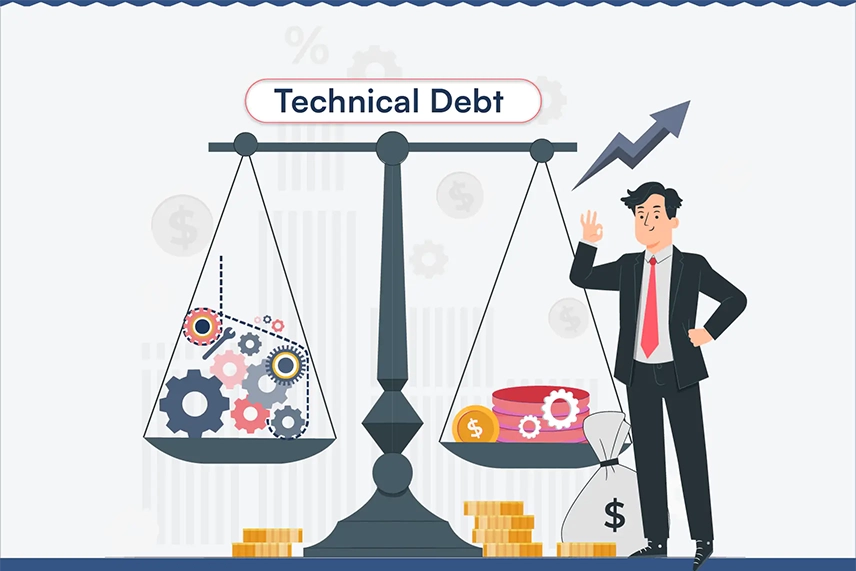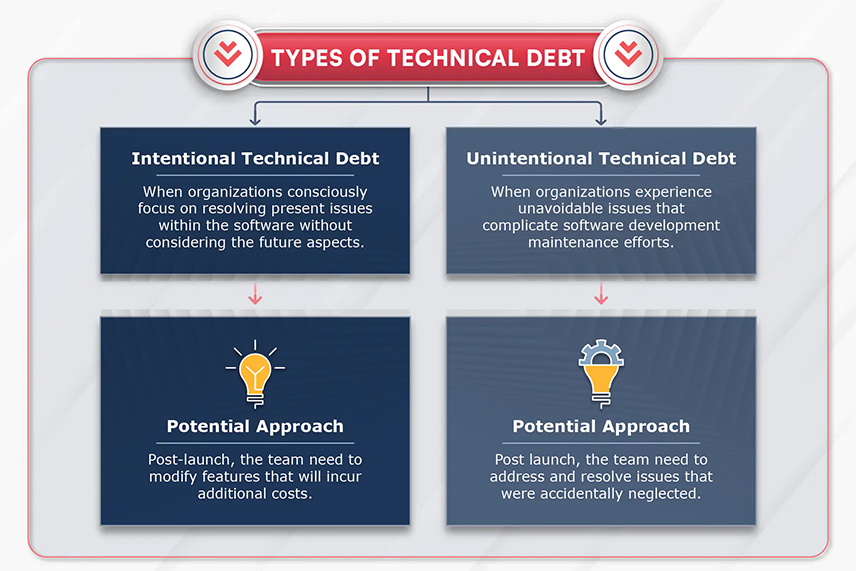
Technical debt management is essential to avoid costly breaches, accelerate product releases, and scale IT operations. It can help organizations ensure high code quality, improve system reliability, and enhance overall business throughput by reducing the time and resources spent on fixing issues and addressing bottlenecks.
However, many organizations are unable to understand the intricacies of technical debt management. They focus primarily on short-term gains, such as meeting tight deadlines or making quick fixes, without considering the long-term consequences of accumulating technical debt. This leads to a build-up of issues that are costly and time-consuming to address later on.
In this blog post, we will explore the best practices for technical debt management and introduce strategic frameworks that can help organizations mitigate its effects. By proactively addressing technical debt, companies can ensure that their software development processes remain efficient and sustainable, allowing them to stay competitive in an ever-evolving market.
What is Technical Debt Management?
Technical debt management refers to identifying, prioritizing, and addressing the quick fixes made across software code, technology architecture, and IT systems to avoid suboptimal code or outdated systems. It involves creating a strategic plan to address existing debt while ensuring that new development practices minimize future debt accumulation.
Technical debt management helps maintain a high-quality technology infrastructure to support faster development, easier maintenance, and quick response to evolving business needs. It ensures technical assets are up-to-date and resilient, enabling teams to innovate more effectively and efficiently while minimizing the risk of costly disruptions and performance issues.
Why is Technical Debt Management the Need of the Hour?
Technical debt management has become more relevant today than ever before. Many organizations strive to rapidly develop and deploy AI features to gain a competitive edge and create a lasting business impact.
However, organizations are unable to match the pace of industry leaders due to their technical debt. This debt hinders their ability to adopt the latest technologies, make necessary changes, or build and release new features to their customers faster.
According to McKinsey, companies could spend up to 40% of their IT budget by 2025 to maintain technical debt.
As companies focus on delivering new features and catering to an expanding customer base, the foundational technology often gets overlooked. This approach makes it difficult to support new customers or add features without significant effort.
Neglecting technical debt creates a vicious cycle where outdated systems stifle business growth. With a robust technical debt management roadmap, companies can ensure their technology infrastructure remains robust and adaptable, seize new opportunities, and sustain long-term success.
Recently, Harbinger conducted an engaging Power Hour on “Addressing Technical Debt: Balancing Growth and Stability.” This thought-provoking roundtable session was hosted by Shrikant Pattathil, President & CTO, Harbinger Group, and featured expert panelists: Anurag Garg, Chief Product Officer, SafetyChain Software; Arun Aggarwal, Vice President, Americas IT & Digital, Embla Medical; and Ajinkya Ambike, Business Consultant, Harbinger Group.
The Power Hour provides valuable insights from these industry experts on how to explore effective strategies and frameworks to create a robust roadmap to identify and resolve technical debt.
6 Best Practices to Create a Robust Technical Debt Management Roadmap
Now that you know the importance of technical debt management, let’s move forward to build a sophisticated roadmap to identify and resolve technical debt. Here are some best practices to get started.
1. Identify the Type of Technical Debt

Understand the nitty-gritty of technical debt – whether it is ‘intentional or unintentional.’ Intentional technical debt is incurred when deliberate trade-offs are made for short-term gains, such as meeting tight deadlines or accommodating temporary changes. Unintentional technical debt arises from a lack of awareness, poor design choices, or evolving requirements.
Identifying the type of technical debt helps create tailored strategies to address particular issues. It can ensure deliberate and accidental debts are managed appropriately. It can effectively communicate technology vision and strategy to internal stakeholders to avoid substandard solutions and enable long-term stability.
2. Use the Right Technology
Select appropriate tools and platforms that best support your technical debt management strategy. Implement modern and scalable technologies to reduce the likelihood of accruing new technical debt and improve the efficiency of managing existing debt. Ensure that technology choices align with long-term business goals and provide easy integration and maintenance capabilities.
3. Prioritize Legacy App Modernization
Legacy applications often harbor significant technical debt due to outdated technologies and practices. Modernizing these applications can yield substantial benefits, including improved performance, security, and sustainability.
Assess which legacy systems are most critical to business operations. Identify key requirements and plan legacy app modernization to minimize disruption, optimize resources, and enhance the system’s long-term viability and efficiency.
4. Define Risks vs ROI Objectives
Create the right balance between the risks associated with technical debt and the ROI of addressing them. Evaluate the potential impact of technical debt on system performance, maintenance costs, and future development.
Compare these risks with the benefits of investing in technical debt management and reduction, such as enhanced system stability and increased development speed. This will help you make informed decisions about the debts to prioritize.
5. Strategize Continuous Analysis and Periodic Reviews
Continuous analysis and periodic reviews are complementary approaches that ensure ongoing monitoring and proactive technical debt management. While continuous analysis involves real-time monitoring and addressing technical debt, periodic reviews provide a more in-depth assessment of the overall system performance over time.
6. Collaborate with Technical Debt Management Experts
Partner with a trusted technical debt solutions provider, such as Harbinger, specializing in technical debt management, technical due diligence for acquisitions, and product end-of-life strategies. This partnership can help assess the current state of your technology infrastructure to identify and resolve technical debt with utmost precision.
3 Strategic Frameworks for Effective Technical Debt Management
Following a framework-based approach can not only maximize the impact of your technical debt management strategy but also boost business growth and productivity. Let’s look at three significant consulting frameworks to give you a better idea.

1. Cloud Consulting Framework
This framework can help organizations navigate the four levels of cloud maturity – cloud enablement, cloud native, serverless, and AI/ML capabilities. It enables effective technical debt management by analyzing cloud maturity and aligning cloud services with strategic business objectives.
2. Integration Consulting Framework
This framework can enable organizations to select the best integration strategy tailored to their niche business requirements. It assesses key factors like cost, scalability, control, and maintenance. It helps choose between custom integration and Integration Platform as a Service (iPaaS) to meet current and future business goals.
3. Experience Consulting Framework
This framework assists organizations in enhancing design accessibility workflows and gathering user feedback using the best practices and latest technologies like AI. It assesses and improves user interface and experience designs across five levels, from basic functionality to advanced intelligent systems.
Final Thought
Technical debt management can help organizations avoid future setbacks in time and resources. It can bridge the gap between quick wins and long-term business success. It guides the leadership team and other stakeholders to make informed decisions, reduce plausible risks, and deliver scalable software products.
If you are looking to build a result-oriented technical debt management strategy or follow a framework-based approach to resolve technical debt, write to us. Our technical debt management experts will help you balance growth and stability to exceed your business goals.





